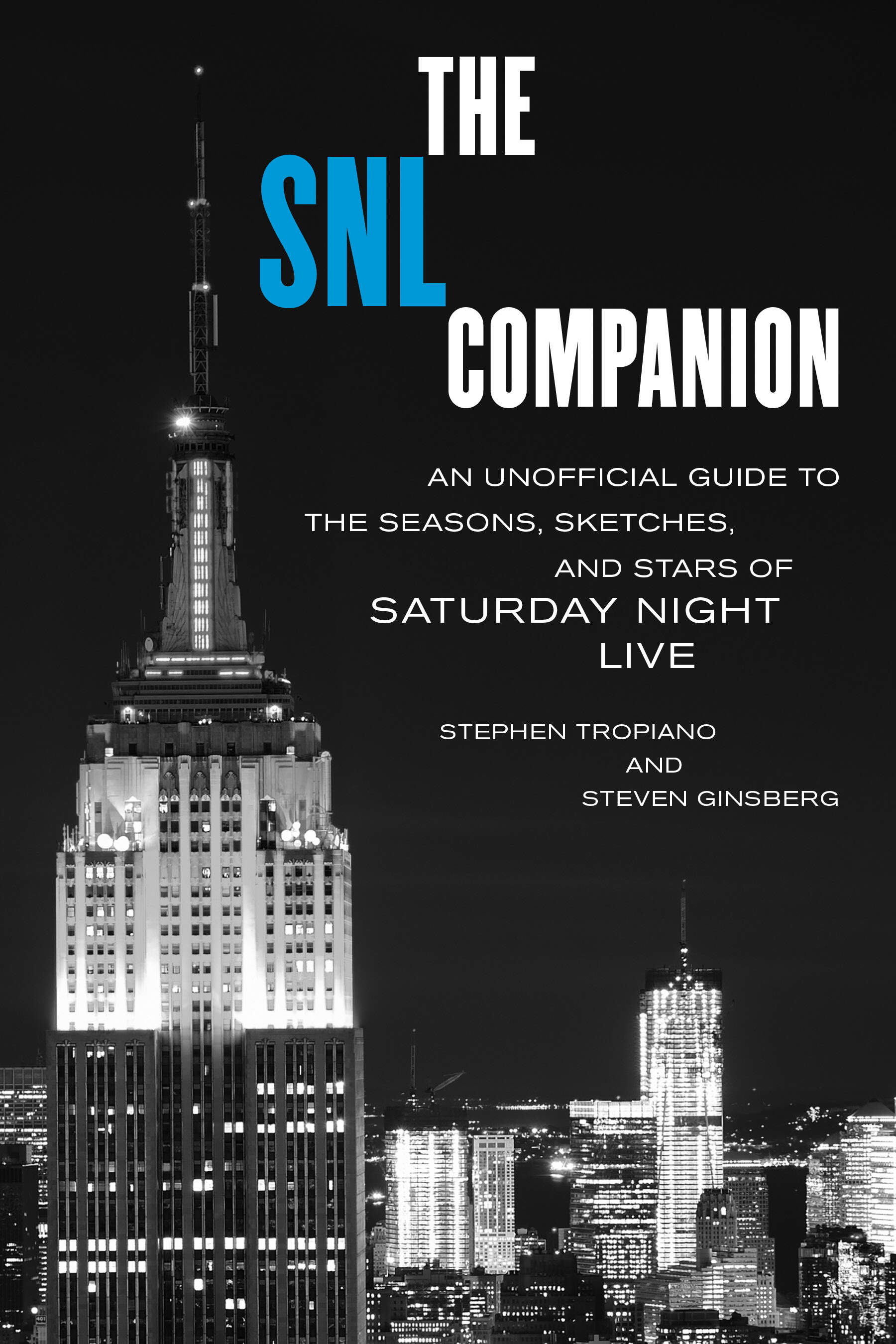Advertisement
50 years of SNL: Coneheads, presidential impressions, musical guests and more

Editor's note: This segment was rebroadcast on Feb. 14, 2025. Click here for that audio.
“Live from New York it’s Saturday night!”: It’s been 50 years since that trademark line and the original theme music of Saturday Night Live debuted on NBC.
The comedy skit show launched generations of American comedy greats and some very quoteable moments. SNL’s 50th anniversary season begins Saturday night.
Ithaca College professor of screen studies Stephen Tropiano co-authored “The SNL Companion: An Unofficial Guide to the Seasons, Sketches, and Stars of Saturday Night Live.” It’s out now in paperback to celebrate the anniversary.
SNL has kept the same format for 50 years: a guest host, a musical guest and wild comedy sketches by a troupe of regulars. At the time, most TV shows appealed to a wide audience, Tropiano says.
“[SNL] was very much a product of the [1960s] in terms of its sensibility, its comic sensibility. Late night shows were things like ‘The Tonight Show’ were more the conventional talk shows,” he says. “It was considered groundbreaking because [of] a combination of its format as well as I think the idea that it would appeal much more to a post-counterculture audience.”

6 questions with Stephen Tropiano
When you were 16, you went to New York to see a rehearsal for Season 3, Episode 10, and you saw John Belushi's first Greek diner sketch and Bill Murray's Nick the Lounge Singer. What was it like to experience that as a 16 year old for the first time?
“What's amazing is, it sounds strange, but how small the studio is and how they have everything kind of crammed in to Studio 8H and how the show moves so fast where they go from one sketch to another to another. Now they do the kind of bumpers where they kind of show you what people standing around waiting for the next thing to happen, but I couldn't believe how fast it went.
“I remember it going by, it was, you know, a 90 minute show that went, it felt like it went by in like 10 minutes because it just kept moving.”
You go back like a year later for another rehearsal and you didn't think it was quite as funny as the first one. Over the years, fans and critics of the show say that it's had funnier moments and also it just misses the mark sometimes too, doesn't it?
“Yes, it does. If you go through all the seasons, I have to say, I do think our memory of things that we think were funny back then, maybe aren't so funny now. But the show has definitely sort of had highs and lows. The cast has changed. And a lot of it also has to do with the writing, which is sort of the unseen thing that holds whole show together.”
What role do you think SNL’s presidential impersonations played in politics and the culture of the United States?
“This is a show that's live, and so it's actually able to do parody and satire for things that are current. When things happen in the summer, I always imagine what Saturday Night Live would have done if the show had been on.
“But I think that it in some ways, [SNL] kind of reflects the culture and I think it kind of defined the culture. Especially, I think, when Sarah Palin was actually on and John McCain were on. They kind of knew they were going to lose so it seemed like they didn't really care very much. But we had Tina Fey imitating her and then we had the real person on. I think that was kind of a bit of a turning point in terms of how it sort of enmeshed the show is in terms of addressing politics.”
Do you think that the women have really driven the show in recent years? For so long, it wasn't easy for them in a male dominated program.
“I think the shift happened around when Tina Fey became the head writer. I would see a lot more content that I would consider much more feminist and much more female centric.
“And it also has to do with who are the breakout stars at the time? When you had someone like Kate McKinnon, and you had someone like Kristen Wiig, they would be writing for them much more. And we were seeing more sketches that were kind of showcasing their talent.”
What do you think we've learned from the show's many mistakes?
“NBC had a very active department that basically had to clear everything. So, how far they're actually gonna go, and some of the things are just because our sensibility has changed. I mean, maybe seeing Will Ferrell dressed as Janet Reno, who actually does appear on the show. So, she had a sense of humor about it.
“Probably the most controversial moment was Sinead O'Connor ripping up a picture of the Pope, which she did not do in rehearsal. And people just went crazy.
“And also, this show, as much as it might seem like things are improvised, there's nothing improvised at Saturday Night Live. Everything is scripted. If anything, what often happens is people burst into laughter, like Ryan Gosling. I think people just watch it just to see him break up. It's not a place for people to sort of improvise and sort of do their own thing. It's part of a much larger machine.”
What’s one of your favorite musical guests?
“I have a few, of course. People like Miley Cyrus, who I always thought of as Hannah Montana. And she sang Paul Simon's ‘50 Ways to Leave Your Lover,’ and it was phenomenal. And it was like seeing someone who's completely different.”
This interview has been lightly edited for clarity.
Lynn Menegon produced and edited this interview for broadcast with Mark Navin. Allison Hagan adapted it for the web.
Book excerpt: 'The SNL Companion: An Unofficial Guide to the Seasons, Sketches, and Stars of Saturday Night Live'
By Stephen Tropiano and Steven Ginsberg
Introduction
Saturday Night Live is an American institution. It is the longest-running sketch comedy show on television—a total of 968 episodes over forty-nine seasons (through May 2024), which, if you do the multiplication and the division, equals approximately 1,117.5 hours of original programming.
Since its debut on October 11, 1975 (under its original title, NBC’s Saturday Night), certain elements of the show have remained consistent: a repertory cast of players, a new guest host and musical guest each week, an opening monologue, Weekend Update, commercial parodies, and, except for a period in the early 1980s, someone opening the show with “Live from New York, it’s Saturday Night!” But when you start to take a closer look at the show and begin to break it down by decade and season, it’s evident that in an effort to stay relevant and maintain its fan base, plus deliver respectable ratings, SNL had to evolve. Change is not necessarily a good thing, and it certainly isn’t always the answer. Then again, just when you think SNL has fallen off America’s radar and is on a creative downward spiral, the public’s interest in the show is suddenly energized and expanded thanks to a talented new cast member, or a digital short that goes viral, or a female governor running for vice president, or a New York real estate developer who gets elected president.
Advertisement
Before you begin reading, let’s get a few points out of the way, beginning with what this book is not. It is not a “tell-all” book about what really went on behind the scenes of the show, nor is it a “set the record straight” book in response to what has already been written about SNL. There are three informative and entertaining books on the history of the show: SNL: Saturday Night: A Backstage History of Saturday Night Live (1986), by Doug Hill and Jeff Weingrad, which deals with its early history; Saturday Night Live: The First Twenty Years (1994), an “authorized” coffee-table book edited by Michael Cader with terrific photos of the show’s early years by Edie Baskin; and the updated edition of Live from New York: An Uncensored History of Saturday Night Live (2015), an oral history by Tom Shales and James Andrew Miller. Shales, a Pulitzer Prize–winning critic for the Washington Post, started writing about SNL from day one and has since been one of the show’s harshest critics and biggest fans.
Speaking of fans—this book is written from the perspective of a “critical fan,” someone who has remained loyal to the show over the years—warts and all—and is willing to put up with all those naysayers who love to go on about how the show is “less funny now” than it used to be. Maybe it’s out of a sense of nostalgia, or the satisfaction we get knowing someone younger missed out on something really special because he or she was born in the wrong decade, but we all have a tendency to romanticize the past, and, in the case of SNL, believe that the show was better back in the day “when I watched it.” But as a genre, sketch comedy shows, particularly one that airs late in the evening, are by their very nature uneven.
Within a single episode, there are typically one or two or more hilarious sketches, a few jokes or moments that warrant a chuckle, and portions of the show that signal that it’s bedtime. The first five seasons of SNL are commonly referred to as the show’s “Golden Age.” The early episodes were stellar, but by no means perfect.
The fact that SNL is uneven should not detract from its unique and significant contribution to American culture. As this book demonstrates, the show has been a cornerstone in popular culture for six decades with its endless supply of recurring characters, catchphrases, and memorable comedic and musical moments. At the same time, through satire, parody, and a fake newscast, SNL has also provided a running commentary on American culture, politics, and society.
SNL has done this by literally becoming the door many of the biggest comedy names in the business have passed through in order to hone their craft, get seen and heard, or simply gain the kind of wider audience that being on a weekly network television series allows. It’s not the only way to it do, but over the years it has become one of the undeniable boot camps for the next generation of comedy talent.
What is not always noted is that these people have then left and gone on to write, create, and/or star in some of the most successful television and movies of our times. Readers can view our credits list of cast members from seasons 1–5, as well as the directory of cast bios for those who followed them. But consider the popularity over the last fifty years of films starring Bill Murray, Adam Sandler, Eddie Murphy, Will Ferrell, Chevy Chase, John Belushi, Dan Aykroyd, and Mike Myers.
Or the impact on TV made by shows created by, produced by, or starring Tina Fey, Larry David, Amy Poehler, Jane Curtin, Julia Louis-Dreyfus, Conan O’Brien, Seth Meyers, Jimmy Fallon, Bill Hader, Jason Sudeikis, Maya Rudolph, Andy Samberg, and Will Forte.
Not to mention writers and directors, like Adam McKay, Michael Schur, Greg Daniels, and Bob Odenkirk.
Or stand-up comedy stars, like Chris Rock, John Mulaney, Sarah Silverman, and Leslie Jones.
Or already-known performers in the cast, like Billy Crystal, Martin Short, and Christopher Guest.
Or comedy talents so unique they had sold-out evenings of their sketch characters on Broadway, like Gilda Radner, or at Carnegie Hall, like Andy Kaufman.
That’s only a very partial list, but you get where we’re going with this.
A single name that repeatedly appears in the pages that follow is the show’s creator, Lorne Michaels. Television is a collaborative medium, and while some critics are hesitant to assign authorship of a television series to a single individual, there is no denying that despite all the limitations imposed on a producer, from budget constraints to network interference, throughout television history there have been producers (most of whom are also writers) who have served as a show’s primary creative force: Norman Lear (All in the Family [1971–1979]), Dick Wolf (Law & Order franchise), David Chase (The Sopranos [1999–2007]), Rod Serling (The Twilight Zone [1959–1964] and Night Gallery [1969–1973]), and Larry David and Jerry Seinfeld (Seinfeld [1989–1998]).
Lorne Michaels produced forty-four of SNL’s forty-nine seasons. Over his fifty-six-year career in television, he has been the recipient of twenty-one Primetime Emmys, the Mark Twain Prize for American Humor, and an individual Peabody Award. But awards are only a part of a much larger story. His contribution to American television comedy is unparalleled, and his influence is immeasurable.
A brief word on how to use this book: In appendix A you will find a list of every episode of Saturday Night Live along with the name(s) of the guest host(s) and musical guest(s) and other pertinent information. The episodes are numbered according to the season and the order in which the episode appeared (for example, 32.4 = season 32, episode 4). A reference to a host, sketch, character, musical performance, cameo, or guest appearance in the book will include the corresponding episode number in parentheses.
All rights reserved.
This segment aired on September 27, 2024.




